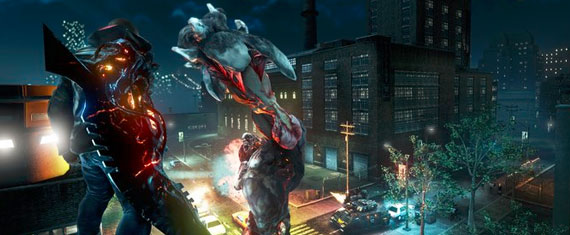 The sandbox genre of games has seen its fair share of entries since GTA III first cracked the open-world code. Although some would argue the Grand Theft Auto series has been the only one to do it right, that would be doing at least a half-dozen other games a serious disservice. Prototype, for instance, released three years ago to serious praise, with an anti-hero shapeshifter as the main character granting players the brutal ability to consume victims in order to gain their appearance and abilities. The sequel, Prototype 2, has recently released for Xbox 360 and PlayStation 3, shifting the protagonist’s perspective somewhat but offering players the same core gameplay mechanics and open-world playground. Like any playground, Prototype 2 is only as fun as you allow it to be, yet in some respects, it’s also something you may feel to have outgrown.
The sandbox genre of games has seen its fair share of entries since GTA III first cracked the open-world code. Although some would argue the Grand Theft Auto series has been the only one to do it right, that would be doing at least a half-dozen other games a serious disservice. Prototype, for instance, released three years ago to serious praise, with an anti-hero shapeshifter as the main character granting players the brutal ability to consume victims in order to gain their appearance and abilities. The sequel, Prototype 2, has recently released for Xbox 360 and PlayStation 3, shifting the protagonist’s perspective somewhat but offering players the same core gameplay mechanics and open-world playground. Like any playground, Prototype 2 is only as fun as you allow it to be, yet in some respects, it’s also something you may feel to have outgrown.
The game takes place 14 months after the original, with New York still a locked-down, disease-infested war zone continuously patrolled by Blackwatch soldiers to keep the Blacklight virus at bay. Alex Mercer, the protagonist from the first Prototype and the one accused of spreading the virus, is no longer in gamers’ control. That honor falls to Sgt. James Heller, a mentally unstable soldier whose family died at the hands of Blacklight-infected crazies and who’s out for revenge against the one who started the whole pandemic. Naturally, this makes Heller the perfect recruit for Blackwatch, who wants nothing more than to contain the disease and Alex Mercer — for less-noble reasons than they’d like the rest of the world to know.
Sgt. Heller, infected by Mercer in Prototype 2’s opening cinematic, gets many of the same shapeshifting powers Mercer enjoyed in the original, plus a few new ones. After all, this is a sequel, so it had to build on the original somehow. With these powers, players will scale buildings, consume Blackwatch soldiers to gain strength and abilities, devour innocent bystanders for energy and to assume their likeness as “camouflage,” and wreak overall havoc and cause massive destruction in the game world.
The world of Prototype 2 is split into three different zones, much like games like Crackdown or, to a lesser degree, the Spider-Man games have been. The Green Zone is heavily guarded and full of military, forcing players to not only deal with plenty of patrols, but also causing an increased focus on consuming innocents and finding other means of calming the alert level of Blackwatch soldiers.
The Yellow Zone has more of an industrial feel visually, with its streets not quite as heavily patrolled but instead filled with refugees and triage camps. Naturally, the opportunities here to encounter more “monsters” are much greater than in the Green Zone, and the Yellow Zone gives Heller a chance to see what the Blacklight virus has wrought — and connect players ’emotionally’ with the backstory of the virus’ true beginnings.
The Red Zone, surprisingly not sponsored by Old Spice, is where things really come to a head, with the virus completely overrunning the place and almost every available human turned into grotesque, powerful freaks just waiting to infect, maim or kill anything that gets in their way.

As an open-world game, Prototype 2 has a variety of side missions and non-essential activities to do and find, with a narrative thread loosely tying them together but really focused more on telling the main campaign’s story. [Spoiler alert for the next sentence] The story focuses on the true origins of the virus, how it was actually engineered as a biological weapon and then conveniently ‘blamed’ on Mercer, with Sgt. Heller thus facing the challenge of balancing a desire for revenge against the man he once thought was ‘responsible’ for killing his family against his desire to get to the bottom of the story and bring the true progenitors to justice.[/spoiler] This is an interesting route for the sequel to take — in fact, maybe the only direction the plot could’ve possibly gone — and it’s rife with potential. Yet it often moves through details far too quickly, even presenting and moving through “bosses” before players have a chance to emotionally connect with the purpose behind their impending death. Because of this, Prototype 2 feels a lot like “wash, rinse repeat” when it comes to enemies, because although bosses are certainly more powerful (and at times larger) than bystanders, you’re often spoon-fed how to defeat them, and the basic mechanics are the same whether you’re facing John Doe or a mega-monster.
It’s for this reason that I said above Prototype 2 may feel like a playground you’ve outgrown. I loved the original Crackdown and felt that the sequel was just OK. The first Prototype was a great romp, yet this sequel just doesn’t quite do it for me. There are certainly some outlandish virus-inspired moves — the Black Hole and Whip Fists are among my favorites — but you can only mix-up the combat mechanics so much before you want a little more narrative meat to hang on those button-mashing bones. The game does inject some RPG-lite elements into things, providing upgradeable abilities and attributes, but they don’t practically affect the experience. So, you’re left blasting through the campaign, hoping all the while for more connection to what could’ve been an outstanding narrative twist but ultimately left wondering “that’s it?” The sequel takes place 14 months after the original, but its real-world release came three years later. Perhaps I really did outgrow it.
But again, Prototype 2 is what you make of it. The graphics are quite good, especially considering the amount of detail in every monster and human in the sandbox world, so biding time with side activities such as eradicating Lairs and finding hidden items can be a nice visual experience. Even setting up your own challenges can be fun, like seeing how many waves of Blackwatch soldiers you can fight off without consuming anyone for energy, or trying to wall-run or glide as far as possible. At the end of the day, though, these are diversions to the main campaign course, and I left the table feeling hungry. Maybe you’re in the right frame of mind or stage of life to enjoy a kill-everything-blindly type of experience. I’m just personally not.
Score: 7: An intriguing plot tries to turn an action-oriented (and bloody) game on its ear, but the gameplay is too repetitive at its core to make you feel like you’ve really experienced something unique in the ever-growing world of sandbox games.
Platform reviewed: Xbox 360
